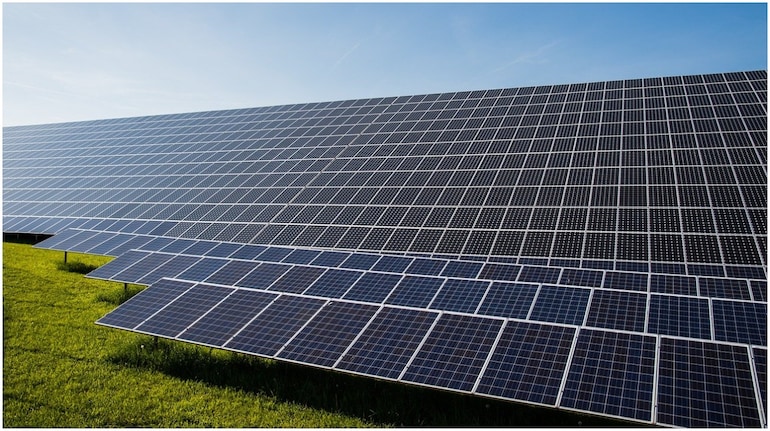



By Hanish Gupta
Solar manufacturing is having a moment in India—not just in headlines, but in factories, boardrooms, and government corridors. In the first eight months of fiscal year 2024-25, India's imports of solar cells and modules declined by 20% and 57%, respectively—a sharp signal of shifting ground. The urgency is palpable. The opportunity? Unmissable.
This significant drop in imports is a testament to India's growing self-reliance in solar manufacturing. Notably, imports from China have decreased substantially, with China's share in India's solar cell imports falling from over 90% to 56%, and in solar module imports to 65% in 2023-24.
It all ties back to a bold national ambition—one that was echoed by Prime Minister Narendra Modi earlier this year at India Energy Week, where he declared that India's solar PV module capacity had surged from 2 GW to 70 GW in a decade. The target now? To be fully self-reliant in solar manufacturing and claim a bigger stake in the global supply chain.
But while the manufacturing wave is rising, the real question is—can we ride it all the way to shore?
Let’s be honest. India’s solar potential has never been in doubt. We have sunlight. We have demand. And we also have the political will. What’s been missing, until recently, is control over the core of the value chain—cells, wafers, and modules. For years, India depended heavily on Chinese imports to meet its solar needs.
That dependence is changing—fast. The government's Production Linked Incentive (PLI) scheme has turbocharged domestic investment in manufacturing, with ₹24,000 crore allocated across two phases. In response, India’s solar PV module manufacturing capacity is set to rise to 125 GW by 2030, up from the current 80 GW. Similarly, solar cell manufacturing capacity is projected to grow from 25 GW to 40 GW in the near future.
Still, manufacturing is a marathon, not a sprint.
There are real hurdles. Manufacturing solar panels isn’t just about capital and machinery. It’s about building scale, securing raw materials, and creating technology partnerships. India continues to import polysilicon and wafers—both critical upstream inputs. Unless we solve that dependency, we’ll remain vulnerable to price shocks and geopolitical risks.
Second, solar manufacturing is a volume game. Plants need high utilization to be economically viable. That requires a strong and consistent domestic offtake market—something the government is trying to ensure with import duties and ALMM (Approved List of Models and Manufacturers) mandates. But policy delays and exemptions have created confusion in the market. Developers need clarity, and manufacturers need predictability.
Third, technology is evolving rapidly. The world is already moving toward TOPCon and HJT cell technologies, with perovskite and tandem cells in the pipeline. Indian manufacturers must invest in R&D and adapt quickly—or risk getting stuck with obsolete production lines. This is especially important if we want to compete in exports—which is where the real growth lies.
Now, here’s the interesting part.
What’s emerging is not just a set of factories, but an ecosystem. From machinery suppliers to raw material processors, testing labs to recycling firms—solar manufacturing has the potential to create thousands of jobs and breed ancillary industries. We're seeing greenfield investments in Tier 2 and Tier 3 cities, which could decentralize economic growth and bring real momentum to Make in India.
For industrial players like those that act as solar solution providers with in-house solar cell, panel, and ground-mounted structure manufacturing and installation services, this shift is transformational. In fact, it complements companies’ businesses. Why? Because vertical integration helps them control quality, timelines, and costs. More importantly, it helps firms reduce their carbon footprint. Local sourcing matters—not just for margins, but for sustainability.
And while manufacturing grabs the spotlight, let’s not forget the end goal: deployment. India has set a target of 500 GW of non-fossil energy capacity by 2030, and solar will account for the lion’s share. To get there, we need more rooftop solar on factories, more utility-scale projects, more hybrid installations with battery storage—and yes, more financing.
That’s where green finance and policy alignment come in. The rise of sovereign green bonds and global climate funds could be a game-changer for manufacturers and developers alike. But tapping into these resources will require transparent ESG disclosures, robust project pipelines, and—frankly—better storytelling. Investors want to back scalable impact. We need to show them what that looks like.
So, where do we go from here?
For India to become a true solar manufacturing powerhouse, three things must happen simultaneously. First, we need to move fast on upstream integration—polysilicon and wafer capacity must be part of our 2030 vision. Second, the government must maintain policy continuity, ensure timely disbursal of PLI funds, and avoid last-minute exemptions that undercut manufacturers. And third, the private sector must double down on tech investments, global partnerships, and execution discipline.
This is not just about modules. It’s about market share. It’s about reducing our energy dependence. And yes—it’s about climate action.
The road ahead is long, but the direction is clear. India is no longer just installing solar power. We’re gearing up to build it, ship it, and own it.
Let’s make it happen.
(Hanish Gupta, Founder and Managing Director, Sunkind India Pvt. Ltd.)
Views are personal, and do not represent the stand of this publication.
Discover the latest Business News, Sensex, and Nifty updates. Obtain Personal Finance insights, tax queries, and expert opinions on Moneycontrol or download the Moneycontrol App to stay updated!